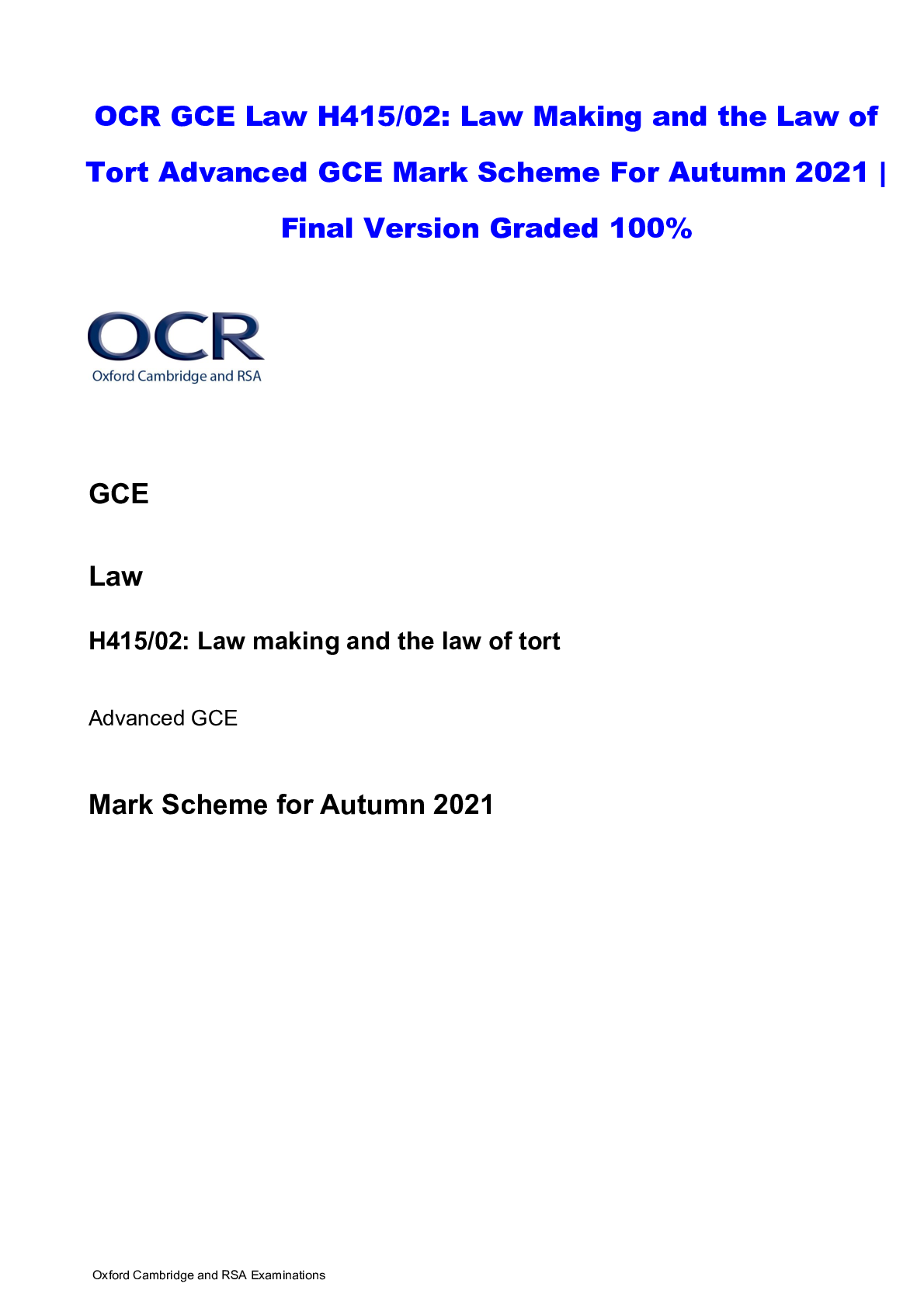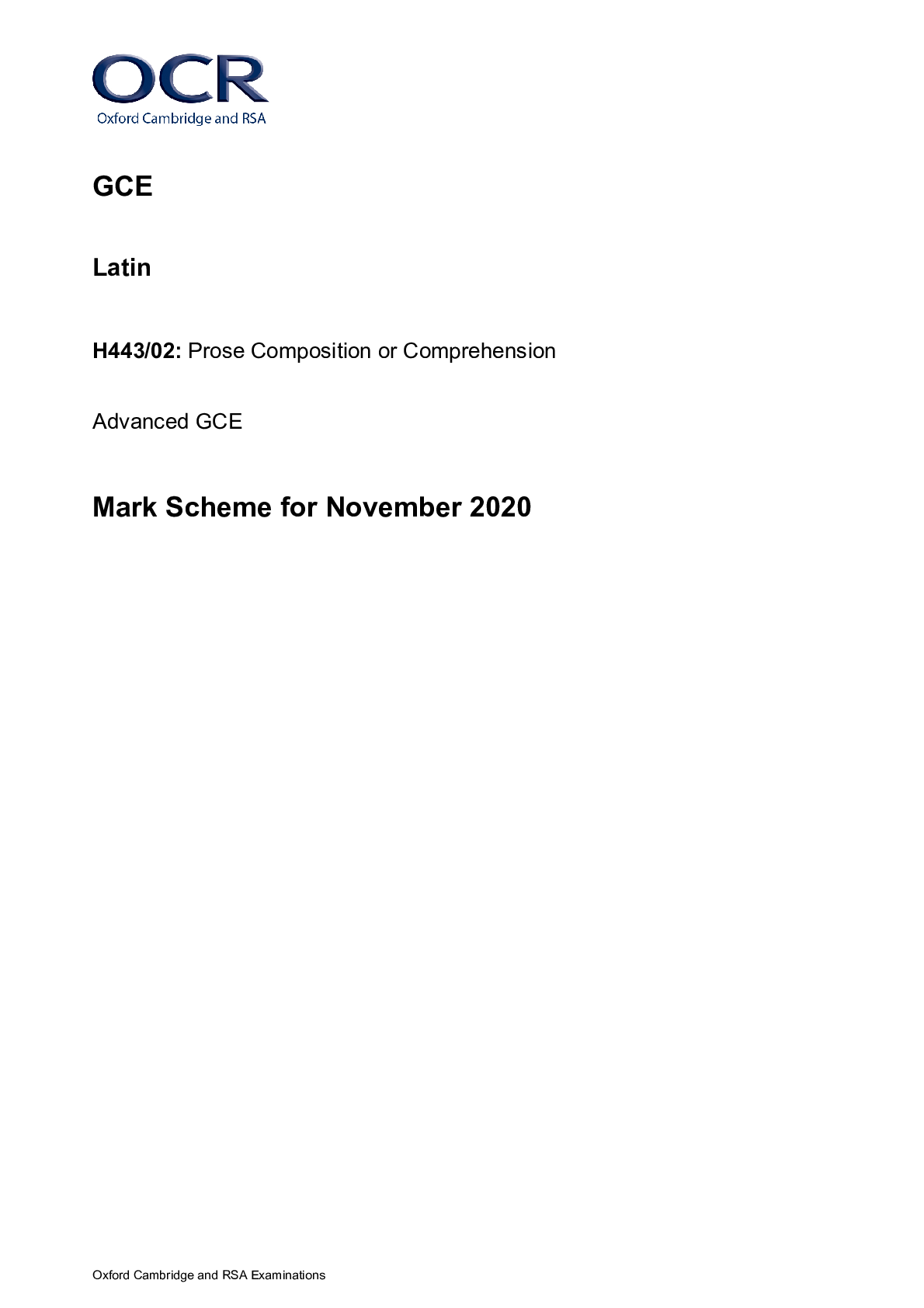Biology > GCSE MARK SCHEME > GCE Biology A H420/01: Biological processes Advanced GCE Mark Scheme for Autumn 2021 (All)
GCE Biology A H420/01: Biological processes Advanced GCE Mark Scheme for Autumn 2021
Document Content and Description Below
GCE Biology A H420/01: Biological processes Advanced GCE Mark Scheme for Autumn 2021 Oxford Cambridge and RSA Examinations GCE Biology A H420/01: Biological processes Advanced GCE Mark Scheme fo... r Autumn 2021Oxford Cambridge and RSA Examinations OCR (Oxford Cambridge and RSA) is a leading UK awarding body, providing a wide range of qualifications to meet the needs of candidates of all ages and abilities. OCR qualifications include AS/A Levels, Diplomas, GCSEs, Cambridge Nationals, Cambridge Technicals, Functional Skills, Key Skills, Entry Level qualifications, NVQs and vocational qualifications in areas such as IT, business, languages, teaching/training, administration and secretarial skills. It is also responsible for developing new specifications to meet national requirements and the needs of students and teachers. OCR is a not-for-profit organisation; any surplus made is invested back into the establishment to help towards the development of qualifications and support, which keep pace with the changing needs of today’s society. This mark scheme is published as an aid to teachers and students, to indicate the requirements of the examination. It shows the basis on which marks were awarded by examiners. It does not indicate the details of the discussions which took place at an examiners’ meeting before marking commenced. All examiners are instructed that alternative correct answers and unexpected approaches in candidates’ scripts must be given marks that fairly reflect the relevant knowledge and skills demonstrated. Mark schemes should be read in conjunction with the published question papers and the report on the examination. © OCR 2021H420/01 Mark Scheme October 2021 Annotations Annotation Meaning DO NOT ALLOW Answers which are not worthy of credit IGNORE Statements which are irrelevant ALLOW Answers that can be accepted ( ) Words which are not essential to gain credit __ Underlined words must be present in answer to score a mark ECF Error carried forward AW Alternative wording ORA Or reverse argumentH420/01 Mark Scheme October 2021H420/01 Mark Scheme October 2021 Question Answer Mark AO element Guidance 1 C 1 1.1 2 B 1 1.2 3 C 1 1.2 4 A 1 1.1 5 C 1 2.1 6 B 1 1.1 7 B 1 2.6 8 B 1 2.6 9 B 1 1.1 10 C 1 2.1 11 D 1 1.1 12 D 1 1.1 13 B 1 1.1 14 A 1 2.7 15 B 1 1.2H420/01 Mark Scheme October 2021 Question Answer Mark AO element Guidance 16 (a) (i) A = sinoatrial node / SA node / SAN B = right , atrium / atria C = (inferior) vena cava D = semilunar valve E = bicuspid / (left) atrioventricular / (left) AV , valve 5 1.1 DO NOT ALLOW sinoarterial ALLOW aortic valve ALLOW mitral valve DO NOT ALLOW tricuspid 16 (a) (ii) autonomic 1 1.1 ALLOW parasympathetic / sympathetic 16 (b) (i) I medulla (oblongata) 2 1.1 16 (b) (ii) heart rate controlled by , nervous / autonomic , system / AW parasympathetic / vagus , nerve reduces heart rate / AW heart rate reduces by (approximately) 30 bpm max 2 3.1 ALLOW heart rate controlled by more than one nerve 16 (b) (iii) hypothalamus AND pituitary produce a wide range of hormones / AW affect other , endocrine / hormone-producing , glands explanation of symptom caused by injury to G or H from Fig. 16.2 max 2 2.1 MP1 ignore letters e.g. damage to thermoregulatory centre in , G / hypothalamus , leads to increased sensitivity to cold e.g. damage to , H / pituitary , means reduction in (named) reproductive hormones which leads to menstrual irregularitiesH420/01 Mark Scheme October 2021 16 (b) (iv) damage to other endocrine glands could cause similar symptoms symptoms (may be) caused by , underlying conditions / other disease / co-morbidity symptoms (may be) result of epigenetic factors max 1 2.1 ALLOW e.g. damage to other organs could cause similar symptoms 16 (c) spinal cord synapses 2 1.1 DO NOT ALLOW spine ALLOW synaptic junction / synaptic gapH420/01 Mark Scheme October 2021 Question Answer Mark AO element Guidance 17 (a) K = islet of Langerhans L = blood vessel 2 2.1 ALLOW arteriole / venule 17 (b) (i) beta / β (cells) 1 1.1 17 (b) (ii) glucose (concentration) causes release of insulin / AW change in insulin secretion is high enough to be measured / AW 2 3.3 2.3 IGNORE synthesis or production of insulin ALLOW amount of insulin (secreted by the cells) was high enough to measure 17 (b) (iii) (unpaired) t-test because they are comparing means 2 3.3 2.3 DO NOT ALLOW paired t-test IGNORE reference to tailed IGNORE standard deviation IGNORE reference to null hypothesis 17 (b) (iv) probability is , less than / < , 0.1% / 0.001 (so) results / differences between means , were due to chance 2 2.4 3.1 ALLOW for 2 marks e.g. there is less than 1 in 1000 probability that the results are due to chance OR ora e.g. there is greater than 99.9% probability that results are not due to chance 17 (b) (v) Ca2+ / calcium ions , do not enter (cells) less / no , exocytosis 2 2.4 ALLOW for 1 max description of what happens without the inhibitor ALLOW less / no , movement of vesicles towards membrane ALLOW less / no , vesicles fuse with membrane DO NOT ALLOW vesicles not secretedH420/01 Mark Scheme October 2021 17 (c)* Please refer to the marking instructions on page 4 of this mark scheme for guidance on how to mark this question. In summary: Read through the whole answer. (Be prepared to recognise and credit unexpected approaches where they show relevance.) Using a ‘best-fit’ approach based on the science content of the answer, first decide which of the level descriptors, Level 1, Level 2 or Level 3, best describes the overall quality of the answer. Then, award the higher or lower mark within the level, according to the Communication Statement (shown in italics): o award the higher mark where the Communication Statement has been met. o award the lower mark where aspects of the Communication Statement have been missed. • The science content determines the level. • The Communication Statement determines the mark within a level. Level 3 (5–6 marks) An evaluation that includes treatments with insulin (past and current) AND includes another treatment (current / potential) e.g. transplant. Includes advantage and disadvantage statements for insulin and another treatment. There is a well-developed line of reasoning which is clear and logically structured. The information presented is relevant and substantiated. Level 2 (3–4 marks) An evaluation that includes treatment with insulin (past or current) AND includes another treatment (current / potential) e.g. transplant. Includes advantage and disadvantage statements for either insulin or another treatment. There is a line of reasoning presented with some structure. The information presented is in the most-part relevant and supported by some evidence. Level 1 (1–2 marks) Description of any treatment for Type I diabetes. Includes an advantage OR disadvantage statement. There is an attempt at a logical structure with a line of reasoning. The information is in the most part relevant. 6 1.1 3.2 Indicative scientific points include: Insulin treatments: past • from animal pancreas e.g. pig current • from e.g. GM / recombinant bacteria / humulin Other current / potential treatments: • transplant of pancreas / islets • transplant of (pancreatic) stem cells • immunotherapies / gene therapy Advantages /disadvantages should be linked to treatment being discussed Advantages of insulin animal-derived insulin • tried and tested method • early treatment kept people alive ‘human’ insulin • high purity • less risk of allergic reaction • lower production cost • overcomes religious / ethical issues of animal products • use of smart pens / pumps • detail of pump use e.g. monitored by apps Disadvantages of insulinH420/01 Mark Scheme October 2021 0 marks No response or no response worthy of credit. animal-derived insulin • needs to be purified • risk of allergic reaction • high production cost • religious / ethical issues of animal products ‘human’ insulin • people persuaded to change from previous insulin regime e.g. animal insulin • some may not understand technology of injection routine • side effects of pumps e.g. hard lumps forming under skin Advantages of other treatments e.g. transplants • less / no need for insulin injections • more physiological control of blood glucose compared with injection • reduce risk of ‘hypos’ • improved quality of life • stem cells turned into functioning β-cells e.g. immunotherapies • ‘reprogrammes’ immune system • prevents / stops damage to β-cells Disadvantages of other treatments: e.g. transplants • requirement for immunosuppression • availability of donor tissue • ethical issues associated with stem cells • risk of cancer with stem cells • not suitable for certain people e.g. those with poor kidney function • may still need low dose of insulin • initial high costs e.g. immunotherapies • still in early stages • need clinical trialsH420/01 Mark Scheme October 2021 Question Answer Mark AO element Guidance 18 (a) (i) N = central vein / intralobular blood vessel O = hepatocyte / liver cell 2 2.1 2.1 ALLOW branch of hepatic vein 18 (a) (ii) thin / flat , cells short diffusion distance OR fenestrated / AW increases permeability max 2 2.1 DO NOT ALLOW thin cell wall 18 (b) prosthetic group induced fit non-competitive inhibition 3 2.1 18 (c) 1 2.2 ALLOW any curve that starts at origin and stays below the curve given in Fig. 18.2. DO NOT ALLOW negative gradientsH420/01 Mark Scheme October 2021 Question Answer Mark AO element Guidance 19 (a) (i) nicotinamide adenine dinucleotide phosphate / NADP 1 1.1 ALLOW NADP+ DO NOT ALLOW NADPH / reduced NADP 19 (a) (ii) (final) electron acceptor replaces , NADP / the usual electron acceptor allows photolysis to continue Max 2 2.3 ALLOW proton / hydrogen (ion) acceptor 19 (a) (iii) Tube A: photosystems / components , are not in , stroma / supernatant / liquid Tube B: proteins / enzymes / (intact) membranes , are needed Tubes C & D: light is required (for electron transport / reduction of DCPIP) Tube E: DCPIP does not spontaneously , decolourise / reduce / AW 4 3.2 ALLOW stage only takes place in chloroplasts / thylakoids / thylakoid membranes ALLOW stage does not take place in the stroma ALLOW photosystems are contained in , thylakoids / thylakoid membranes / pellet / sediment ALLOW ATP synthase needed ALLOW reactions stop when , enzymes denatured / membranes disruptedH420/01 Mark Scheme October 2021 19 (a) (iv) (buffer) maintains optimum pH OR enzymes / proteins , have an optimum pH (no sucrose) no need to prevent damage to chloroplasts / AW OR damage to chloroplasts increases access of DCPIP to (reaction) components max 2 2.7 3.4 1 max for buffer and 1 max for sucrose ALLOW if pH changes , proteins / enzymes , denature 19 (a) (v) I1 use ice-cold solutions E1 prevents damage to components / reduces rate of enzyme reactions I2 centrifuge at different speeds E2 to obtain different fractions / AW OR to obtain a pellet containing mainly chloroplasts / AW I3 use , a heat shield / water bath E3 so that temperature (of all tubes) is , not a variable / controlled / kept constant I4 use same , light source / distance from light source , for illuminated tubes E4 so that light , intensity / wavelength , is , not a variable / controlled / kept constant (for those tubes) max 4 3.3 1 mark for each improvement (I) and 1 mark for correct explanation (E). Explanation must correspond to improvement I1 ALLOW keep , extract / AW , cold E2 ALLOW to remove , cell debris / nuclei / membranesH420/01 Mark Scheme October 2021 19 (b) (i) respiration produces , carbon dioxide / CO2 , that is used in photosynthesis photosynthesis produces , oxygen / O2 , that is used in respiration dead leaves / decomposition , replaces (named) nutrients max 1 2.5 2.5 19 (b) (ii) because they are xerophytes because the conditions are too , moist / wet max 1 2.1 2.1 ALLOW suited to / live in , dry environments IGNORE hot environmentH420/01 Mark Scheme October 2021 Question Answer Mark AO element Guidance 20 (a) P1 do not allow air to enter , cut end / shoot E1 prevent airlock / ensures continuous column of water OR P2 keep named abiotic factor constant / AW E2 affects , rate of transpiration / evaporation of water OR P3 keep screw clip closed E3 prevents entry of water whilst measuring / AW max 2 1.2 1 mark for precaution and 1 mark for corresponding explanation P1 ALLOW method that prevents entry of air, e.g. cutting / assembling under water P1 IGNORE do not introduce air bubbles into the capillary tube. P2 e.g. temperature / humidity 20 (b) (i) FIRST CHECK ON ANSWER LINE If answer = 2.3 award 2 marks SD = 2.30217 Correct answer to 2 s.f. 2 2.8 ALLOW for 1 mark 2.30 20 (b) (ii) data for ‘fan off’ are , more spread out about the mean / less precise 1 3.2 ALLOW data were less repeatable ALLOW ora for ‘fan on’ 20 (c) (i) flatten / AW , leaves (on to graph paper) account for / AW , partially covered squares double leaf area to give total of both surfaces / AW max 2 2.6 ALLOW e.g. only count squares more than 50% coveredH420/01 Mark Scheme October 2021 20 (c) (ii) FIRST CHECK ON ANSWER LINE If answer = 4.9 x 10–2 award 2 marks 30 mm3 min–1 = 1 800 mm3 hr–1 = 1.8 cm3 hr–1 1.8 ÷ 37 = 0.0486 = 4.9 x 10–2 cm3 hr–1 cm–2 2 2.6 2.6 Must be 2SF and standard form for 2 marks If answer is incorrect ALLOW for 1 mark 0.049 / 0.0486 20 (d) (produced) in , meristems / cambium (by) differentiation (from stem cells) 2 1.2 ALLOW specialised IGNORE mitosisH420/01 Mark Scheme October 2021 Question Answer Mark AO element Guidance 20 (e)* Please refer to the marking instructions on page 4 of this mark scheme for guidance on how to mark this question. In summary: Read through the whole answer. (Be prepared to recognise and credit unexpected approaches where they show relevance.) Using a ‘best-fit’ approach based on the science content of the answer, first decide which of the level descriptors, Level 1, Level 2 or Level 3, best describes the overall quality of the answer. Then, award the higher or lower mark within the level, according to the Communication Statement (shown in italics): o award the higher mark where the Communication Statement has been met. o award the lower mark where aspects of the Communication Statement have been missed. • The science content determines the level. • The Communication Statement determines the mark within a level. Level 3 (5–6 marks) A description that includes mass flow and phloem loading and unloading. There is a well-developed line of reasoning which is clear and logically structured. The information presented is relevant and substantiated. Level 2 (3–4 marks) A description that includes mass flow and phloem loading or unloading. There is a line of reasoning presented with some structure. The information presented is in the most-part relevant and supported by some evidence. Level 1 (1–2 marks) A description that includes either mass flow or phloem loading or unloading. There is an attempt at a logical structure with a line of reasoning. The information is in the most part relevant. 0 marks 6 1.1 Indicative scientific points may include Phloem loading • Glucose is converted to an assimilate / sucrose in photosynthesising cells • Apoplast route • Active process • Proton pump in companion cells • H+ concentration gradient • Co-transport of H+ and sucrose into companion cell • Structural adaptations of companion cells, e.g. many mitochondria, increase surface area of cell surface membranes • Passive loading via symplast route • Role of plasmodesmata • entry of sucrose / solutes decreases water potential of phloem / sieve elements • water enters phloem from surrounding cells / xylem • results in higher hydrostatic pressure Mass flow • Bulk transport of sucrose caused by pressure difference • Entry / exit of water / solutes affects hydrostatic pressure • Movement from source to sink • e.g. leaf is sourceH420/01 Mark Scheme October 2021 No response or no response worthy of credit. • e.g. root is sink • Role of hydrostatic pressure gradient from source to sink • High hydrostatic pressure in source phloem explains rapid transport over long distance Phloem unloading • Diffusion of sucrose from phloem to surrounding cells • Sucrose converted back to glucose • Glucose used for respiration • Converted to starch for storage • Concentration gradient of sucrose maintained between phloem and cells • Occurs wherever cells need glucose / sucrose • Loss of sucrose / solutes increases water potential of phloem • water leaves phloem to surrounding cells / xylem • results in lower hydrostatic pressureH420/01 Mark Scheme October 2021 Question Answer Mark AO element Guidance 21 (a) (i) (water potential) decreases / more negative 1 1.1 21 (a) (ii) large plasma proteins cannot , pass out through capillary wall / leave the blood , but other solutes can imbalance of large plasma proteins between blood and tissue fluid results in oncotic pressure 2 2.1 21 (b) (i) Jv = (4.5 – 0.15) – 0.75 (4.2 – 0.03) = 1.22 (kPa) out of capillary / outward 2 2.2 ALLOW 1.2 / 1.2225 / 1.223 ALLOW into tissue fluid 21 (b) (ii) reduction in albumin concentration reduces (capillary) oncotic pressure (so) increase the net driving force 2 2.2 21 (b) (iii) student is correct because… net driving force , is higher / has increased (so) more tissue fluid formed student is incorrect because.... kidney damage could lead to more loss of water (in urine) no information about , hydrostatic pressure / tissue oncotic pressure , in patients single patient could respond atypically (inflammation leading to) reduction in value of reflectance factor could increase , albumin / protein , in tissue fluid max 4 3.1 ALLOW less , fluid / water , returned to blood ALLOW reduction in σ could increase oncotic pressure in tissue fluidH420/01 Mark Scheme October 2021 Question Answer Mark AO element Guidance 21 (c) 3 correct 2 correct Statement True False Lymph is similar in composition to tissue fluid but has more oxygen. Tissue fluid does not contain lymphocytes because they are too large to pass through capillary wall. Lymph contains more protein than tissue fluid because of antibody production by plasma cells. 2 1.1 IGNORE crossesOCR (Oxford Cambridge and RSA Examinations) The Triangle Building Shaftesbury Road Cambridge CB2 8EA OCR Customer Contact Centre Education and Learning Telephone: 01223 553998 Facsimile: 01223 552627 Email: [email protected] [Show More]
Last updated: 1 year ago
Preview 1 out of 21 pages
Instant download
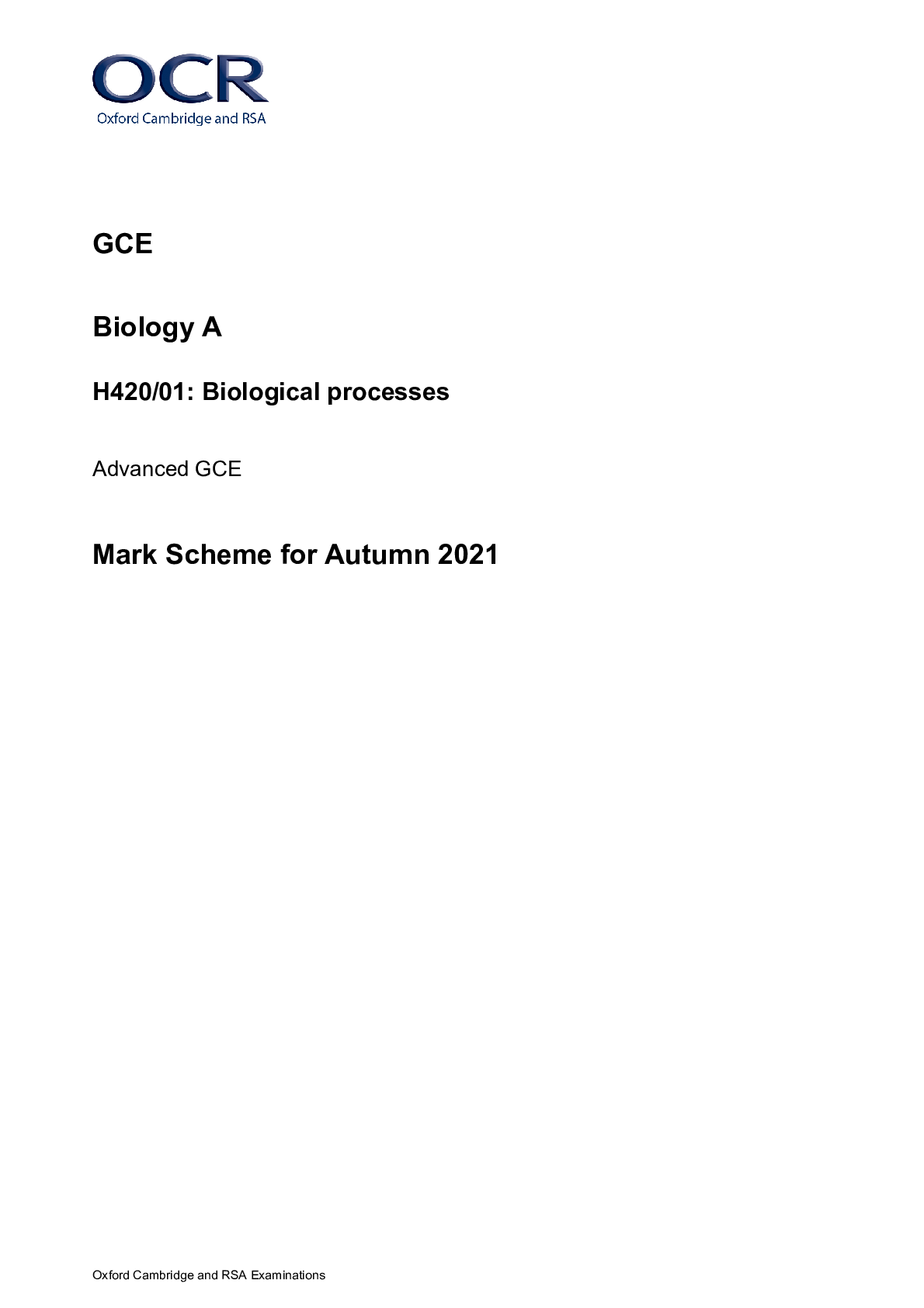
Buy this document to get the full access instantly
Instant Download Access after purchase
Add to cartInstant download
Reviews( 0 )
Document information
Connected school, study & course
About the document
Uploaded On
Oct 07, 2022
Number of pages
21
Written in
Additional information
This document has been written for:
Uploaded
Oct 07, 2022
Downloads
0
Views
33

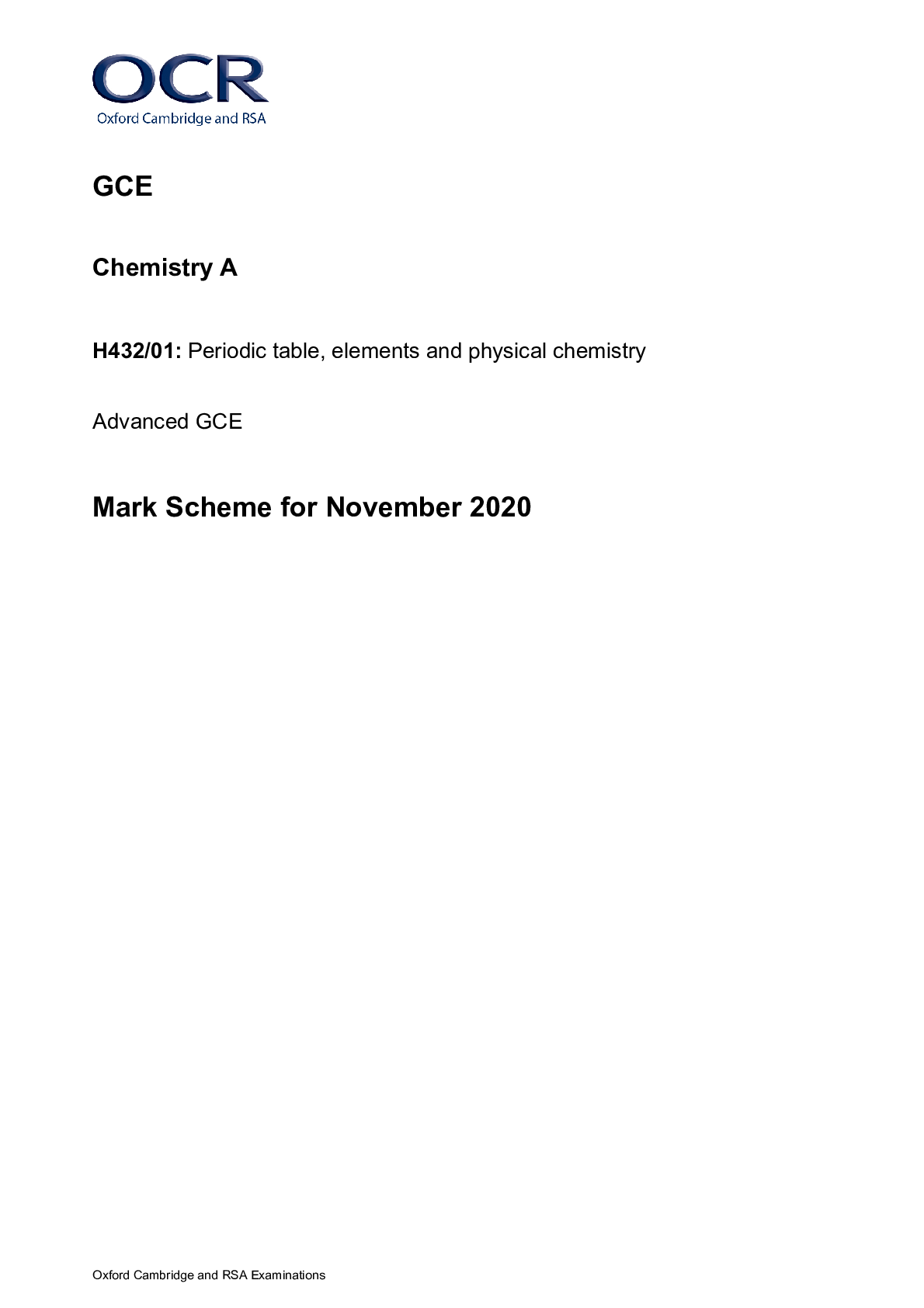

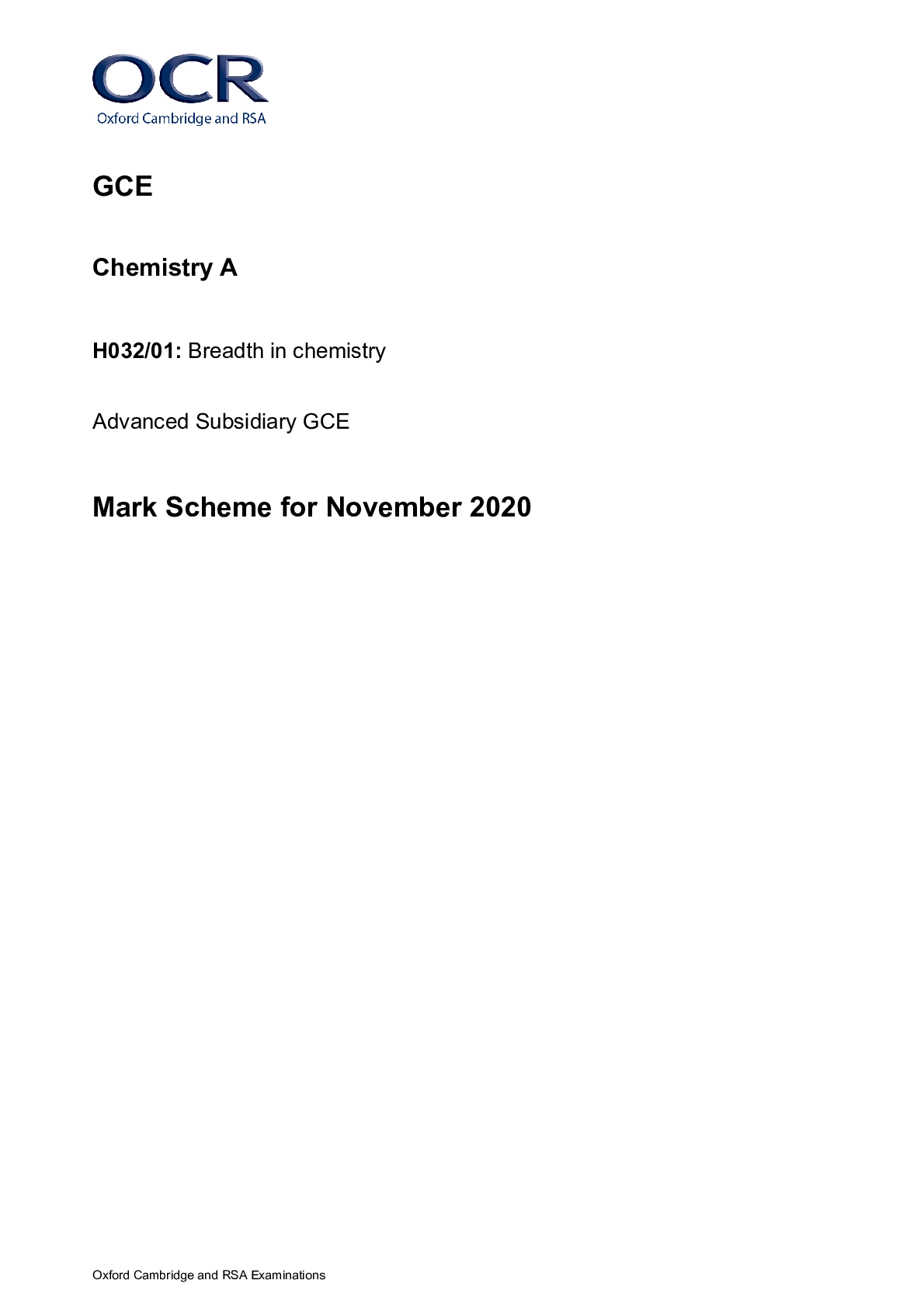


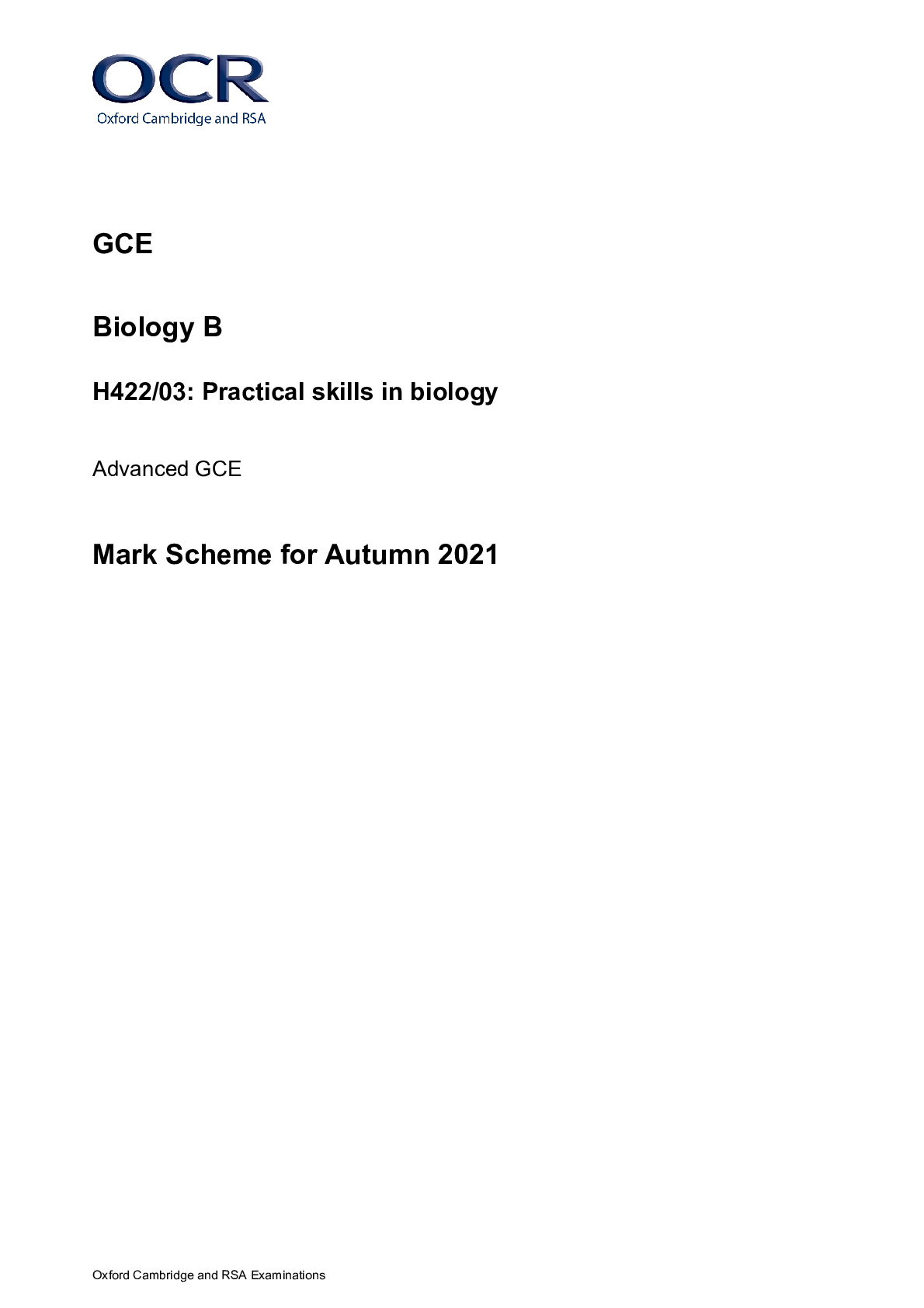

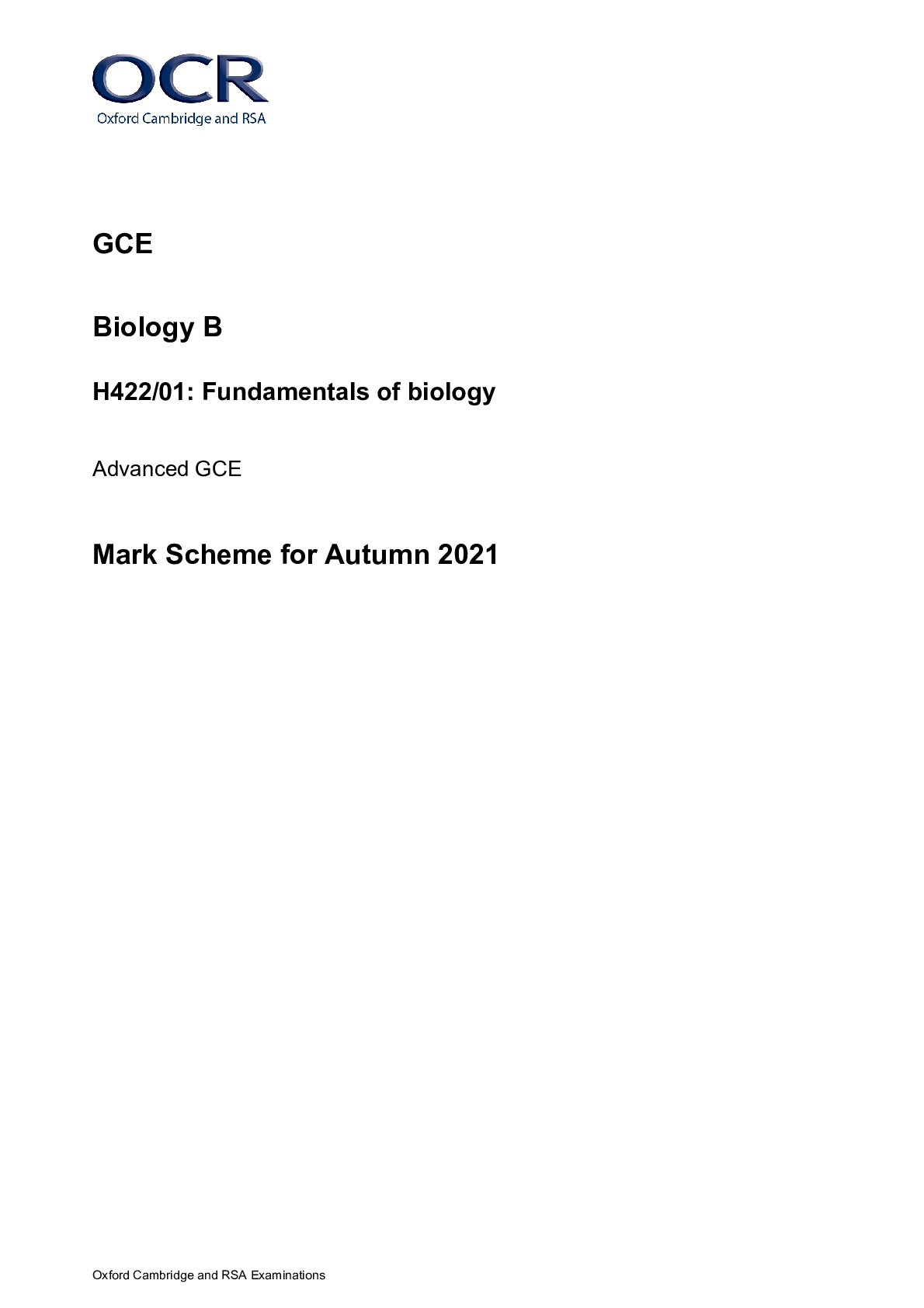
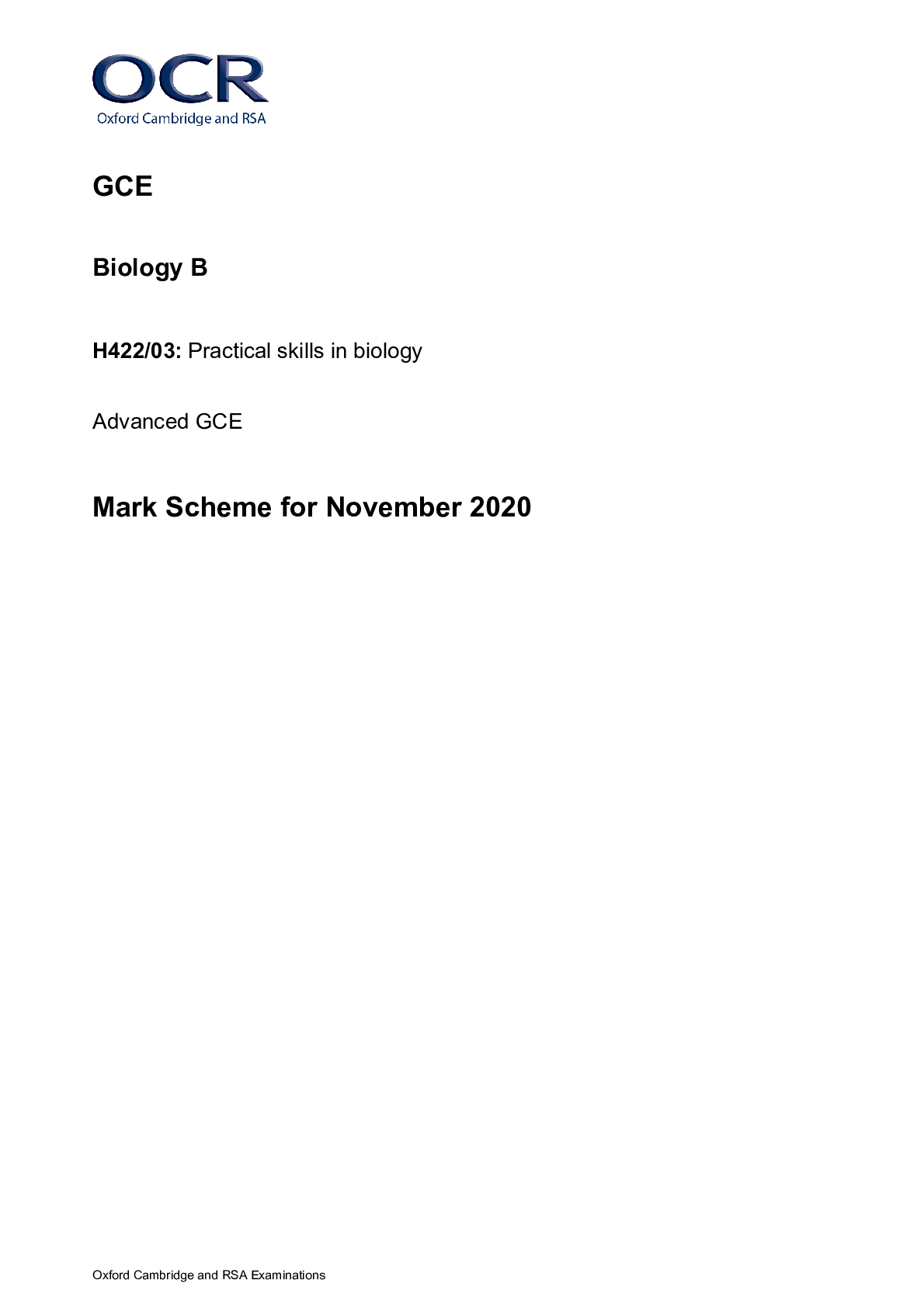
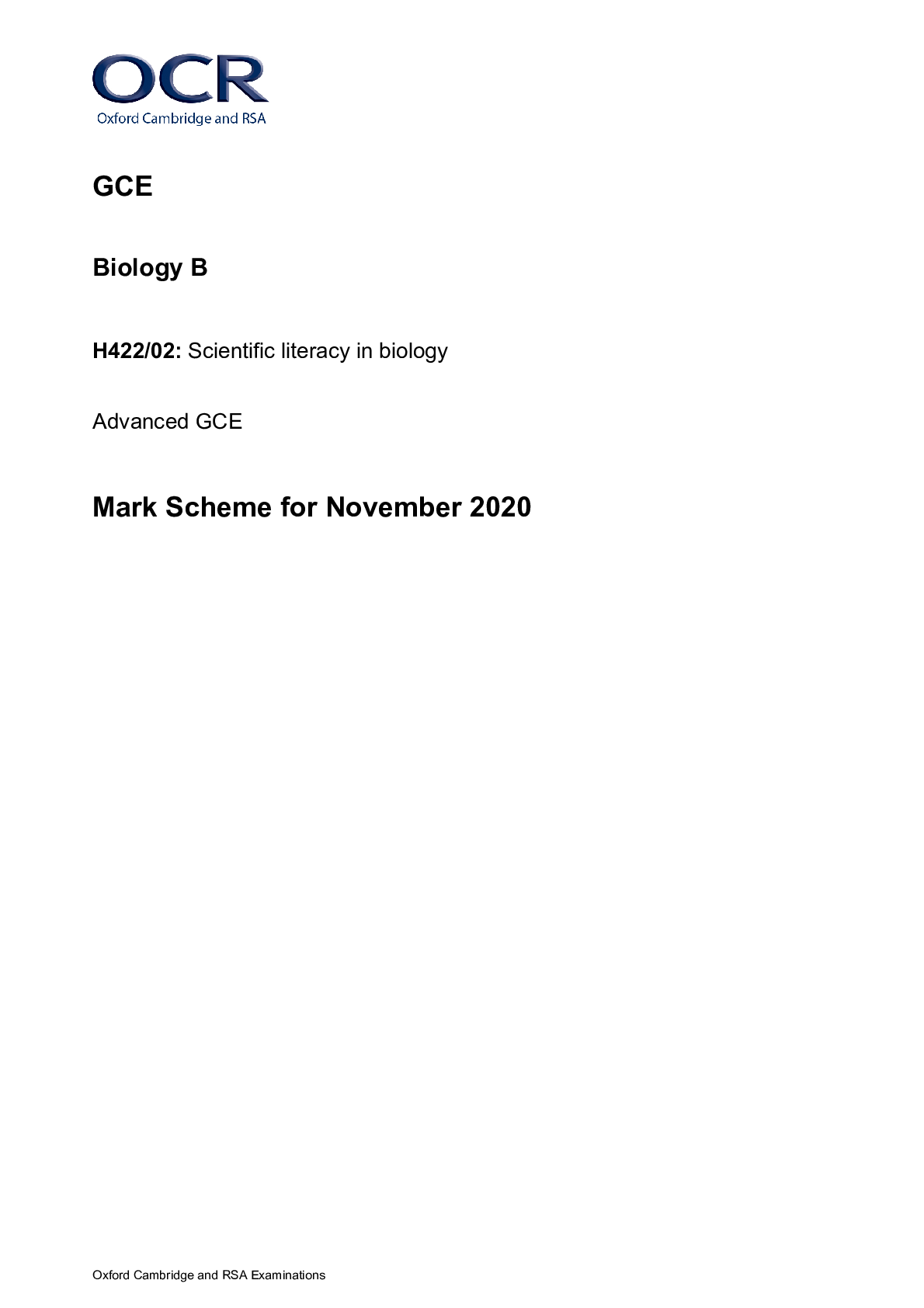
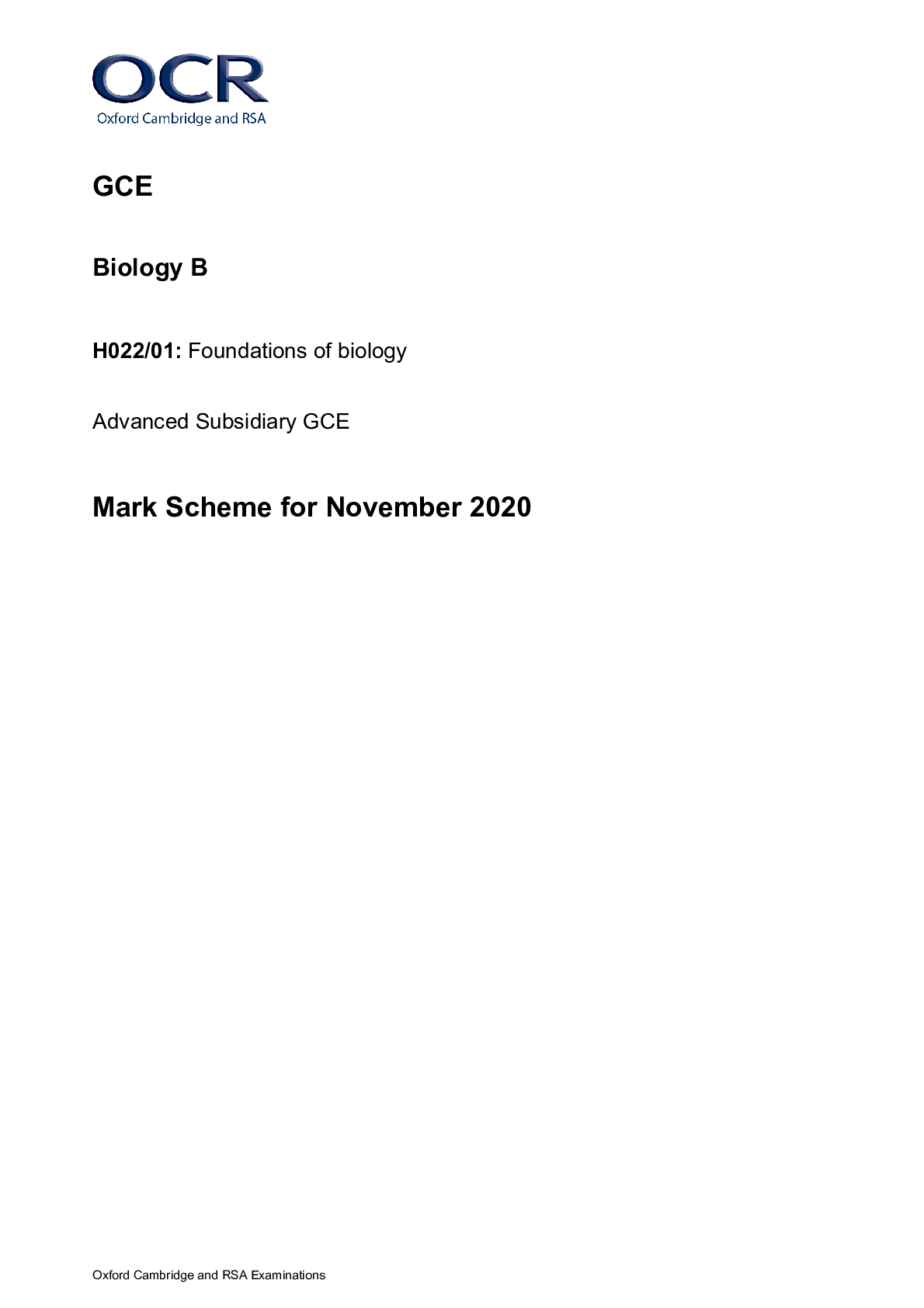




.png)
H630-02 Pure Mathematics and Statistics Advanced Subsidiary GCE Mark Scheme for Autumn 2021.png)

